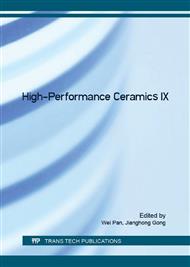[1]
C. C. L. Mahder Tewolde, H. Tao, H. Chen, et al., Sensors for Small Modular Reactors Powered by Thermoelectric Generators, in ASME 2014 Small Modular Reactors Symposium, Washington, DC, USA, (2014).
DOI: 10.1115/smr2014-3371
Google Scholar
[2]
T. Carstens, M. Corradini, J. Blanchard, and Z. Ma, Thermoelectric powered wireless sensors for spent fuel monitoring, in Advancements in Nuclear Instrumentation Measurement Methods and their Applications (ANIMMA), 2011 2nd International Conference on, 2011, pp.1-6.
DOI: 10.1109/animma.2011.6172931
Google Scholar
[3]
T. Carstens, M. Corradini, J. Blanchard, and M. Zhenqiang, Monitoring dry-cask storage using thermoelectric powered wireless sensors, in Instrumentation and Measurement Technology Conference (I2MTC), 2013 IEEE International, 2013, pp.747-752.
DOI: 10.1109/i2mtc.2013.6555515
Google Scholar
[4]
B. Poudel, Q. Hao, Y. Ma, et al., High-Thermoelectric Performance of Nanostructured Bismuth Antimony Telluride Bulk Alloys, Science, vol. 320, pp.634-638, May 2, 2008 (2008).
DOI: 10.1126/science.1156446
Google Scholar
[5]
Y. Ma, Q. Hao, B. Poudel, et al., Enhanced Thermoelectric Figure-of-Merit in p-Type Nanostructured Bismuth Antimony Tellurium Alloys Made from Elemental Chunks, Nano Letters, vol. 8, pp.2580-2584, 2008/08/01 (2008).
DOI: 10.1021/nl8009928
Google Scholar
[6]
Y. Xiao, G. Chen, H. Qin, et al., Enhanced thermoelectric figure of merit in p-type Bi0. 48Sb1. 52Te3 alloy with WSe2 addition, Journal of Materials Chemistry A, vol. 2, pp.8512-8516, (2014).
DOI: 10.1039/c4ta01554a
Google Scholar
[7]
M.Y. Kim, Y.H. Yeo, D.H. Park and T.S. Oh, Thermoelectric characteristics of the (Bi, Sb)2(Te, Se)3 nanocomposites processed with nanoparticle dispersion, Ceram. Inter., vol. 38, Supp. 1, pp. S529-S533, (2012).
DOI: 10.1016/j.ceramint.2011.05.069
Google Scholar
[8]
K. Ahmad, P. Wei, and C. Wan, Thermal conductivities of alumina-based multiwall carbon nanotube ceramic composites, J. Mater. Sci., vol. 49, pp.6048-6055, 2014/09/01 (2014).
DOI: 10.1007/s10853-014-8327-8
Google Scholar
[9]
Q. Jiang, H. Yan, J. Khaliq, et al., Large ZT enhancement in hot forged nanostructured p-type Bi0. 5Sb1. 5Te3 bulk alloys, Journal of Materials Chemistry A, vol. 2, pp.5785-5790, (2014).
DOI: 10.1039/c3ta13952b
Google Scholar
[10]
R. Venkatasubramanian, E. Siivola, T. Colpitts, and B. O'Quinn, Thin-film thermoelectric devices with high room-temperature figures of merit, Nature, vol. 413, pp.597-602, (2001).
DOI: 10.1038/35098012
Google Scholar
[11]
F. Li, X. Huang, Z. Sun, et al., Enhanced thermoelectric properties of n-type Bi2Te3-based nanocomposite fabricated by spark plasma sintering, J. Alloys Comp., vol. 509, pp.4769-4773, (2011).
DOI: 10.1016/j.jallcom.2011.01.155
Google Scholar
[12]
K. Ahmad, W. Pan, and Z. X. Qu, Multifunctional Properties of Alumina Composites Reinforced by a Hybrid Filler, International Journal of Applied Ceramic Technology, vol. 6, pp.80-88, (2009).
DOI: 10.1111/j.1744-7402.2008.02257.x
Google Scholar
[13]
T. Kyratsi, E. Hatzikraniotis, M. Ioannou, et al., Seebeck and thermal conductivity analysis in amorphous/crystalline β-K2Bi8Se13 nanocomposite materials, J. Appl. Phys., vol. 110, p.033713, (2011).
DOI: 10.1063/1.3610393
Google Scholar


